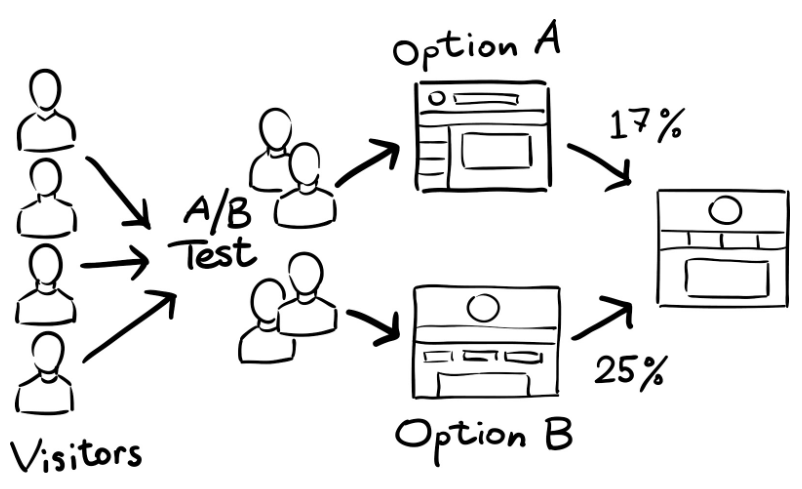The purpose of any business website is to build trust, grow brand recognition, and of course to convert prospects into customers. This seems simple enough, but the challenge is the billions of other websites competing for attention.
As a business owner, you must have your SEO content and PPC game on point. if you hope to funnel traffic into landing pages. But you’re just not getting the conversions you want.
Sounds like you could have a CRO (conversion rate optimization) problem.
What is CRO? How does CRO affect your revenue and online business growth?
Whether you realize it or not, organic growth in traffic doesn’t always correlate with an increase in revenue or leads.
Getting the visitors to your site is only half the battle, and that’s where CRO (conversion rate optimization) comes in.
More specifically, CRO is the practice of optimizing your website or landing page experience based on website visitor behavior. This, in turn, helps improve conversions on those specific pages. CRO marketing and CRO strategy has become a big part of how businesses increase the volume of sales and revenue in their business.
In this article, we’ll look at conversion optimization, improving site page conversion rates, and implementing CRO best practices as a part of your digital marketing. By the end of reading you will be moving closer to becoming a CRO expert, and able to boost your website conversion rate.

What is a Conversion?
A conversion happens when a website visitor to your site completes a designated goal, like submitting a form or making a purchase.
In simple terms, a conversion happens when you transform X into Y. Depending on your business goals, a conversion can take several different forms.
Conversion optimization types can include:
- leads
- email signups
- purchases
- form completions
- and more
With so many different types of conversions, and conversion techniques, it’s easier to place them in two distinct categories.
The first is a macro-conversion, which is when a user completes a purchase transaction that represents the primary objective of your site or a specific page.
The second is a micro-conversion, which represents a completed activity like signing up for an email newsletter.
Macro-Conversion Examples:
- Paid subscription purchase
- Ecommerce website order completion
- Filling out a quote form
- Requesting a demo (SaaS model)
Micro-Conversion Examples:
- Signing up for a newsletter
- Adding to a wishlist
- Creating an account
- Watching a video

How to Calculate Conversion Rates
The conversion rate is calculated this way:
The number of site visitors to your site or page divided by the number of people who fulfill the desired call to action during a given period x100.
This metric doesn’t paint the whole picture, but it does give you a good idea of the effectiveness of your site.
For example:
If you have 5000 visitors and 50 of them completed an action (made a purchase or filled out a form) the conversion rate is as follows:
50/5000×100=1%
Make Sure Your Conversions Count
Of course, a solid conversion rate doesn’t always correlate with an increase in revenue. That’s why we need to look at a variety of factors to assess your main conversion goal, which is making money!
Here are a couple of factors to keep in mind when looking at the conversion rate.
Do you have a Strong Brand?
The more potential customers trust your brand, the easier it will be to convert their interest into an action or purchase. The best landing pages and a huge PPC budget will only put make-up on the pig if people don’t trust your brand.
Are you Devaluing your Service?
Don’t assume all is well when your conversion rate skyrockets. For example, giving away a free demo or product will undoubtedly lead to conversions, but do you have a plan to benefit from that conversion? On the other end, if your offer is perceived as having less value than the price or required action, your conversion rate will be abysmal.
Does your Message Make Sense?
Your product or offering may hold a lot of value for potential site visitors, but if you can’t communicate that value, it doesn’t matter. For example, you might have a beautiful landing page that draws users in, but you also need persuasive web copy that helps relay the value proposition to the customer.

Why is CRO Important?
The amount of PPC competition for valuable ad space is skyrocketing, and SERPs are flooded with an insane amount of organic content.
This is why CRO is more important than ever before. If you’re lucky enough to attract a website visitor, you need to make sure there’s a decent chance they’ll convert.
In fact, improving your conversion rate by just 1% can make a huge impact on overall revenue.
Best of all, experimenting and running CRO tests will improve the overall user experience and quality of your site.
The constant tweaking and experimenting that comes with CRO will help you learn more about your customers. You’ll learn what kind of language and messaging works best with your audience.
CRO also helps your business scale without having to increase your marketing and advertising spend. More specifically, your business might grow faster than the number of customers. That means you need to focus on converting the traffic you already have.
Understanding CRO vs. SEO
A lot of people wonder if CRO and SEO (search engine optimization) are actually the same thing.
After all, CRO is the process of increasing the percentage of visitors to a site that eventually make a purchase or complete an action like signing up for a newsletter. On the surface, it sounds similar to SEO.
But the big difference is that SEO focuses on improving the online visibility of a website through natural, organic, or earned results.
Let’s go over a couple of distinctions between the two disciplines.
How CRO is different from SEO
- The end goal of CRO is to increase conversion rates. On the other hand, SEO has a broader focus of driving organic traffic to a site or page.
- Unlike SEO, CRO does not directly impact traffic coming from Google.
- CRO is all about on-page optimizations, whereas SEO encompasses on-page, off-page, and technical aspects.
- A CRO campaign is often less expensive to run, and you should see results fairly quickly (if done right). SEO is a long-term process and solution.
Similarities between CRO & SEO
- A CRO campaign should lead to a better on-page user experience, which will ultimately help with overall SEO efforts.
- Both SEO and CRO campaigns focus on the same important metrics like bounce rate and time-on-page.
- A web page optimized for CRO will have a better chance of attracting backlinks.
Remember that CRO works well when SEO is already doing its job. In a perfect world, SEO and CRO work together to guide a user through Google’s search results all the way to the final desired conversion on your site.

3 Steps to Grow Your CRO
1) Research & Gather Data
The first step in any CRO audit or campaign is to begin gathering data and forming hypotheses. This data should be built off the company (goals & KPIs), customers (how they interact with the page), and the overall website (usability sales funnel). Once complete, you can start forming hypotheses based on what you think will fix potential customer pain points.
2) Experiment With Specific Hypotheses in Mind
Now it’s time to put your data to use and started testing optimizations to the landing pages. Before pushing full steam ahead, there are a couple of things you should keep in mind. Ask yourself, are the changes directly testing my hypothesis, are the tweaks sticking with the overall style of the website, and are the changes easily implemented. If the answer is yes to these, start testing your changes monitoring the data.
3) Review the Campaign
After statistical significance is reached, sift through the analytics and conversion data to see if your initial hypothesis was correct. The final steps of the review stage are to widely roll out optimizations based on correct hypotheses and continue to test and tweak any changes that didn’t produce the desired result.

5 Best Practices for Better CRO
1) Don’t run too many tests at the same time. This will make it more difficult for you to determine what actually made a difference in your conversion rate.
2) Try to form your insights from data rather than opinions. Every CRO test should help you get more accurate data.
3) Never tweak and experiment without first determining a hypothesis. For example, start with something like: By changing (X) on (Y page) for (Z visitors), we will increase (chosen conversion metric) due to (why).
4) Make sure the goal of your experiments and optimizations is clearly defined and laid out.
5) Don’t just look at top competitors and copy them. You don’t know what their goals and objectives are. What works for them won’t necessarily work for you.
Getting Started with CRO
CRO is exploding in popularity in 2021 and for a good reason. If you want to truly maximize your return on investment without spending multiple months, an arm, and a leg, CRO is the way to go.
The CRO process can take some time to get a handle on. But keep in mind, your CRO efforts will pay off as long as you focus on testing and using the data to keep improving your customer journey for your target audience.
It all sounds great on the surface, but remember that combing through the data and formulating precise hypotheses is easier said than done. You website should act as a conversion funnel, and each page element should only be changed if backed up by user testing data.
To help you get started, here is a list of useful CRO resources and tools.
CRO Resources
- A 5-Step Framework for Conversion Rate Optimization
- CRO Statistics: How to Avoid Reporting Bad Data
- 7 User-Centric CRO Best Practices from 25 CRO Experts
- The Beginners Guide to Landing Pages
- The Beginner’s Guide to Creating Landing Page Copy That Sticks
CRO Tools & Software
- Google Analytics: Google’s web analytics service
- Crazy Egg: Heatmaps & A/B testing
- Hotjar: Heatmaps & behavior analytics
- Sessioncam: Session replay & intelligent web optimization services
- Instapage: Advertising conversion cloud
- Qualaroo: User research & user feedback software
- Optimizely: experimentation platform for A/B & multivariate tests
- Unbounce: Landing page builder & platform
- Google Content Experiments: non-multivariable A/B tests















